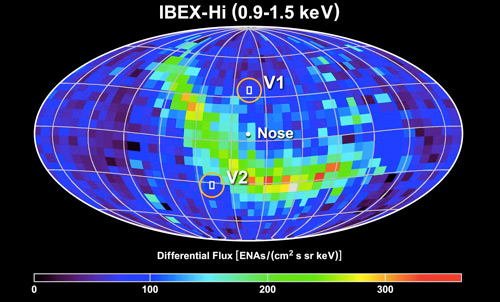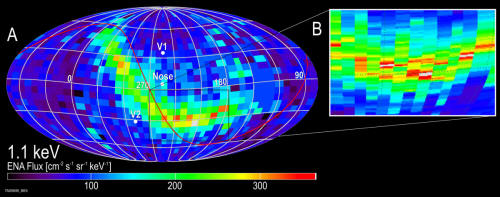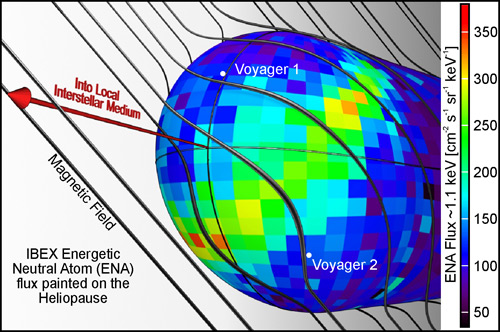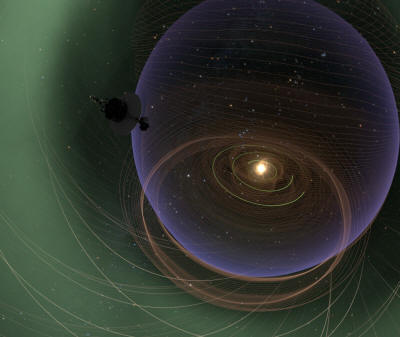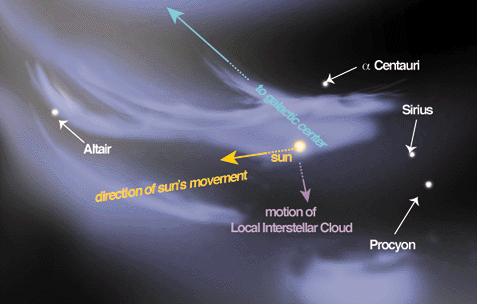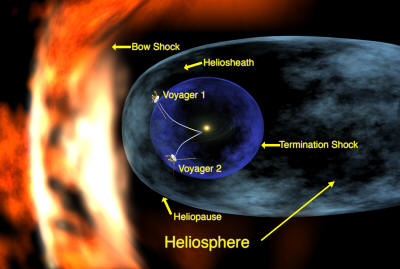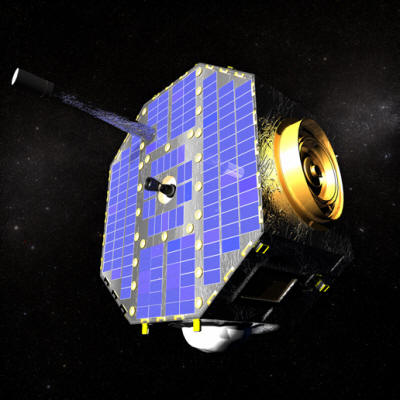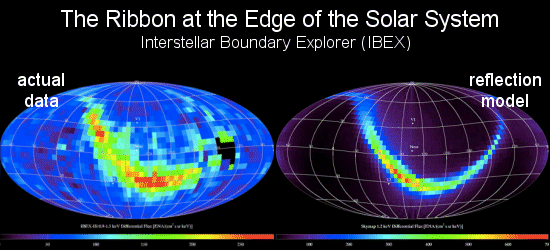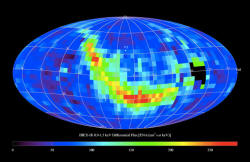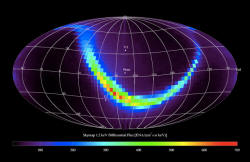|
|
|
from ScienceNASA Website
For years, researchers have known that the solar system is surrounded by a vast bubble of magnetism.
Called the "heliosphere," it springs from the sun and extends far beyond the orbit of Pluto, providing a first line of defense against cosmic rays and interstellar clouds that try to enter our local space.
Although the heliosphere is huge and literally fills the sky, it emits no light and no one has actually seen it. Until now... NASA's IBEX (Interstellar Boundary Explorer) spacecraft has made the first all-sky maps of the heliosphere and the results have taken researchers by surprise.
The maps are bisected by a bright, winding ribbon of unknown origin:
IBEX's all-sky map of energetic neutral atom emission reveals a bright filament of unknown origin. V1 and V2 indicate the positions of the Voyager spacecraft. [more]
Although the ribbon looks bright in the IBEX map, it does not glow in any conventional sense. The ribbon is not a source of light, but rather a source of particles - energetic neutral atoms or ENAs.
IBEX's sensors can detect these particles, which are produced in the outer heliosphere where the solar wind begins to slow down and mix with interstellar matter from outside the solar system.
Unlike the Voyager spacecraft, which have spent decades traveling to the edge of the solar system for in situ sampling, IBEX stayed closer to home.
It is in Earth orbit, spinning around
and collecting ENAs from all directions. This gives IBEX the unique
"big picture" view necessary to discover something as vast as the
ribbon.
The fine structure is as much of a
mystery as the ribbon itself, researchers say.
Understanding the physics of the outer heliosphere is important because of the role it plays in shielding the solar system against cosmic rays.
The heliosphere's size and shape are key factors in determining its shielding power and, thus, how many cosmic rays reach Earth. For the first time, IBEX is revealing how the heliosphere might respond when it bumps into interstellar clouds and galactic magnetic fields.
from ScienceNASA Website
In the Dec. 24th issue of Nature, a team of scientists reveal how NASA's Voyager spacecraft have solved the mystery.
Voyager flies through the outer bounds of the heliosphere en route to interstellar space. A strong magnetic field reported by Opher et al in the Dec. 24, 2009, issue of Nature is delineated in yellow.
The discovery has implications for the
future when the solar system will eventually bump into other,
similar clouds in our arm of the Milky Way galaxy.
The existential mystery of the Fluff has to do with its surroundings. About 10 million years ago, a cluster of supernovas exploded nearby, creating a giant bubble of million-degree gas.
The Fluff is completely surrounded by this high-pressure supernova exhaust and should be crushed or dispersed by it.
So how does the Fluff survive?
The Voyagers have found an answer.
* A microgauss is one millionth of a gauss, a unit of magnetic field strength popular among astronomers and geophysicists. Earth's magnetic field is about 0.5 gauss or 500,000 microgauss.
An artist's concept of the Local Interstellar Cloud, also known as the "Local Fluff." Credit: Linda Huff (American Scientist) and Priscilla Frisch (University of Chicago)
[more]
NASA's two Voyager probes have been racing out of the solar system for more than 30 years.
They are now beyond the orbit of Pluto and on the verge of entering interstellar space - but they are not there yet.
The Fluff is held at bay just beyond the edge of the solar system by the sun's magnetic field, which is inflated by solar wind into a magnetic bubble more than 10 billion km wide.
Called the "heliosphere,"
this bubble acts as a shield that helps protect the inner solar
system from galactic cosmic rays and interstellar clouds. The two
Voyagers are located in the outermost layer of the heliosphere, or "heliosheath,"
where the solar wind is slowed by the pressure of interstellar gas.
These crossings were key to Opher et al's discovery.
The anatomy of the heliosphere. Since this illustration was made, Voyager 2 has joined Voyager 1 inside the heliosheath, a thick outer layer where the solar wind is slowed by the pressure of interstellar gas. Credit: NASA/Walt Feimer.
The size of the heliosphere is determined by a balance of forces: Solar wind inflates the bubble from the inside while the Local Fluff compresses it from the outside.
Voyager's crossings into the heliosheath
revealed the approximate size of the heliosphere and, thus, how much
pressure the Local Fluff exerts. A portion of that pressure is
magnetic and corresponds to the ~5 microgauss Opher's team has
reported in Nature.
On the other hand, astronauts wouldn't have to travel so far because interstellar space would be closer than ever.
These events would play out on time scales of tens to hundreds of thousands of years, which is how long it takes for the solar system to move from one cloud to the next.
To read the original research, look in the Dec. 24, 2009, issue of Nature for Opher et al's article, "A Strong, Highly-Tilted Interstellar Magnetic Field Near The Solar System."
by Dr. Tony Phillips from ScienceNASA Website
Now the mystery may have been solved.
Heerikhuisen is the lead author of a paper reporting the results in the Jan.10th edition of the Astrophysical Journal Letters.
An artist's concept of the Interstellar Boundary Explorer (IBEX).
The IBEX data fit in nicely with recent results from Voyager (above report).
Voyager 1 and 2 are near the edge of the solar system and they also have sensed strong* magnetism nearby.
Voyager measurements are relatively
local to the spacecraft, however. IBEX is filling in the "big
picture." The ribbon it sees is vast and stretches almost all the
way across the sky, suggesting that the magnetic field behind it
must be equally vast.
The ribbon emits these particles, which are picked up by IBEX in Earth orbit.
A comparison of IBEX observations (left) with a 3D magnetic reflection model (right).
More images: data (left), model (right).
Particles from the solar wind that escape the solar system are met ~100 astronomical units (~15 billion kilometers) away by an interstellar magnetic field.
Magnetic forces intercept the escaping particles and sling them right back where they came from.
And upon this field, the future may
hinge.
However, the bubble itself is vulnerable to external fields. A strong magnetic field just outside the solar system could press against the heliosphere and interact with it in unknown ways.
Will this strengthen our natural shielding - or weaken it?
No one can say.
An artist's concept of interstellar clouds in the galactic neighborhood of the sun. [more]
It seems we can learn a lot by looking
in the mirror. from LouisVillemojo Website
As they
double-checked the data and determined that the readings were not in
error, and as they realized the immense size of what they were
beholding, they may well have had the same creeping sense of horror
and awe as when it gradually dawned on the cast of Star Wars that
they were seeing the Death Star.
Not only that, but both our previous Voyager deep-space probes failed to detect it.
The current attempt to explain the mysterious ribbon is a theory that it's a reflection of solar wind particles being reflected back into the solar system by a galactic magnetic field.
They've whipped up a mathematical model that, made to order, predicts a boomerang shaped barrier much like the one that is baffling astronomers.
Not everyone agrees with the theory, however, and we can probably expect much wrangling, arguing, and forehead-smiting for a long time to come.
What this means for Earth's future is uncertain.
As the latest NASA article on the space ribbon states:
These discoveries about the outer fringe of our solar system come at a time when new NASA revelations have piled up so fast and so frequently that our paradigm is completely changing again and again without the general public even really being aware.
Most of us grew up being told in school that there were nine, maybe ten, planets in the solar system, and we now know that there are hundreds of thousands of them.
And far from being chunky bits of
asteroid debris as previously believed, we now know that many of
them are spherical and even have their own moons, like the planet
Pulcova or the planet
Haumea or the astonishingly
Earth-like planet
Ceres.
(And it presents a real migraine for astrologers, I'm sure, who are now faced with the problem of charting over 231,665 planets in our solar system alone! And that doesn't even include the 430 known planets in other star systems.)
|


